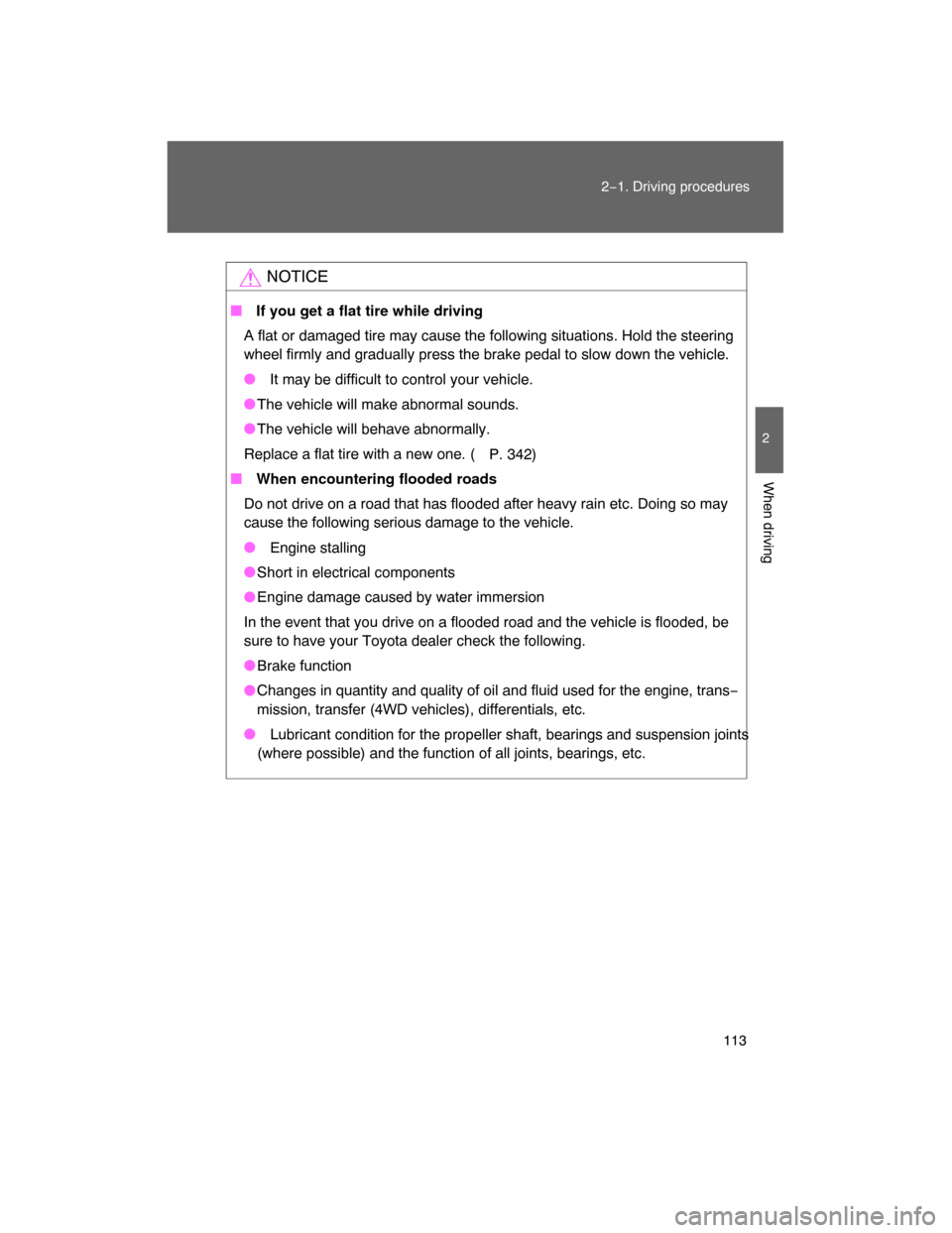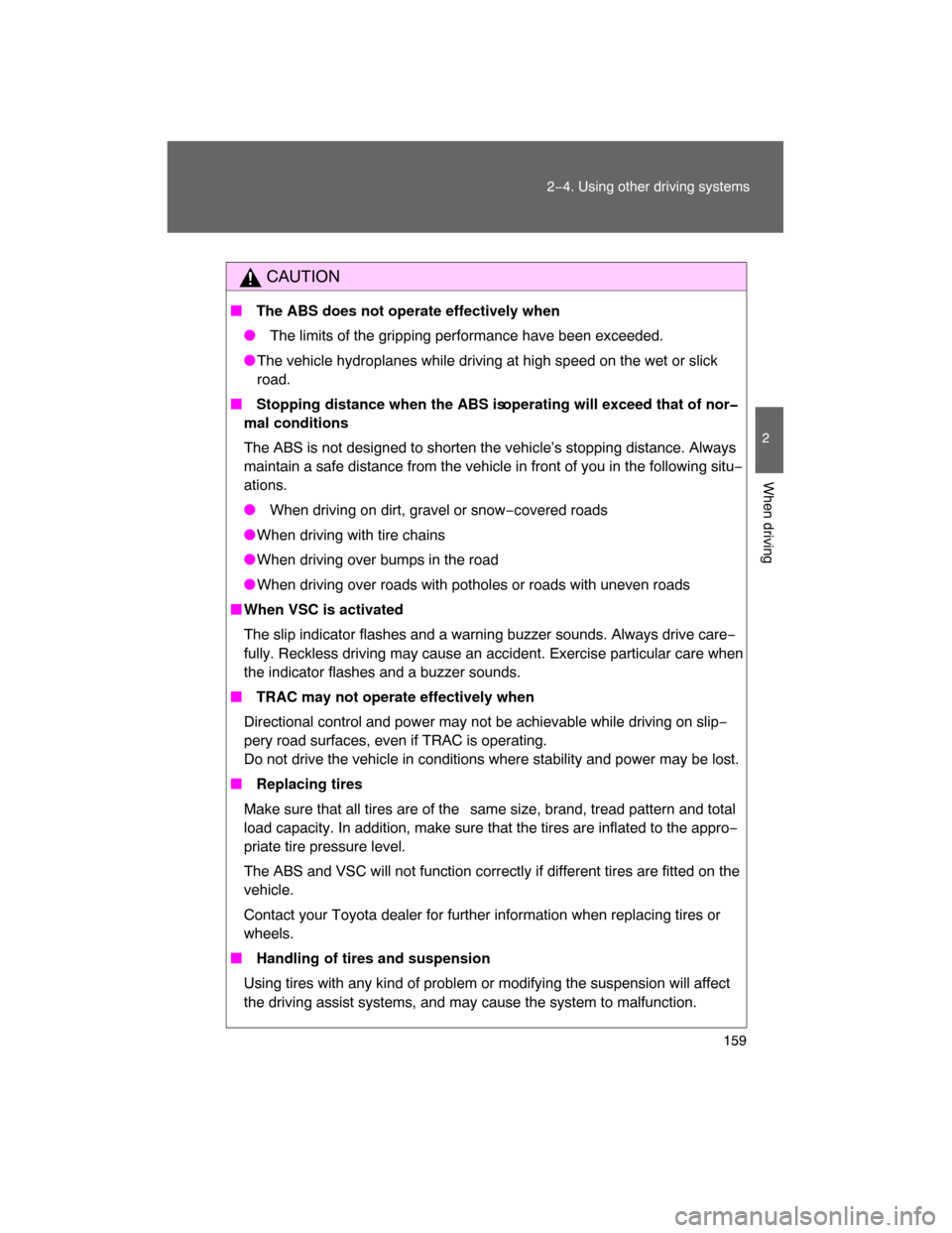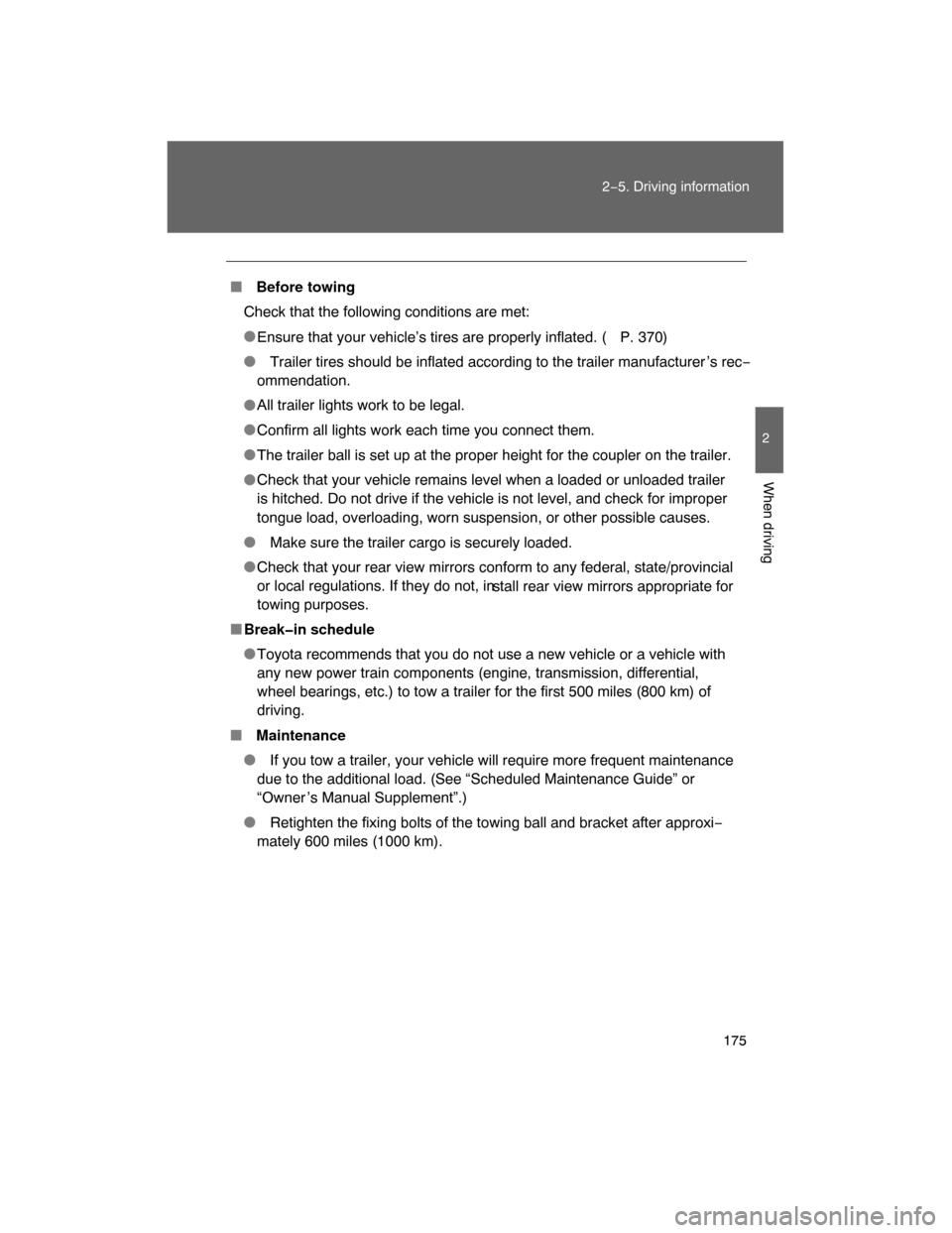Page 1 of 400
TABLE OF CONTENTS
1 1
Before drivingAdjusting and operating features such as door locks,
mirrors, and steering column.
2When drivingDriving, stopping and safe−driving information.
3Interior
featuresAir conditioning and audio systems, as well as other in−
terior features for a comfortable driving experience.
4Maintenance
and careCleaning and protecting your vehicle, performing do−it−
yourself maintenance, and maintenance information.
5When trouble
arisesWhat to do if the vehicle needs to be towed, gets a flat
tire, or is involved in an accident.
6Vehicle
specificationsDetailed vehicle information.
7For U.S.
ownersReporting safety defects for U.S. owners
IndexAlphabetical listing of information contained in this
manual.
Page 4 of 400

TABLE OF CONTENTSIndex
4
Floor mat ............................ 247
Luggage storage box (vehicles
without sub woofer) .......... 248
Luggage compartment
features ............................ 249
Compass ............................ 252
4�1. Maintenance and care ...... 258
Cleaning and protecting the
vehicle exterior ................. 258
Cleaning and protecting the
vehicle interior .................. 260
4�2. Maintenance ..................... 263
Maintenance
requirements .................... 263
General maintenance ......... 265
Emission inspection and
maintenance (I/M)
programs .......................... 268
4�3. Do�it�yourself
maintenance ................... 269
Do−it−yourself service
precautions ...................... 269
Hood ................................... 273
Engine compartment .......... 274
Tires ................................... 287
Tire inflation pressure ......... 292
Wheels ............................... 296
Air conditioning filter ........... 298
Key battery ......................... 301
Checking and replacing
fuses ................................ 303
Light bulbs .......................... 3145�1. Essential information ....... 322
If your vehicle needs to be
towed ................................ 322
If you think something is
wrong ................................ 327
Fuel pump shut off
system .............................. 328
Event data recorder ............ 329
5�2. Steps to take in an
emergency ...................... 331
If a warning light turns on
or a warning buzzer
sounds... ........................... 331
If you have a flat tire ........... 340
If the engine will not start .... 350
If the shift lever cannot be
shifted from P ................... 351
If you lose your keys ........... 352
If the vehicle battery is
discharged ........................ 353
If your vehicle overheats ..... 356
If the vehicle becomes
stuck ................................. 359
6�1. Specifications ................... 362
Maintenance data
(fuel, oil level, etc.) ........... 362
Fuel information .................. 372
Tire information ................... 375
4Maintenance and care
5When trouble arises
6Vehicle specifications
Page 7 of 400
7
A
Tires
�Rotation
�Replacement
�Inflation pressure
�
Information
P. 287
P. 340
P. 292
P. 375
Access doorsP. 36
Fuel filler doorP. 64
Rear turn signal lightsP. 121
Stop/tail and rear side
marker lights
P. 131
Side doorsP. 33
: If equipped
Page 111 of 400

113
2−1. Driving procedures
2
When driving
NOTICE
� If you get a flat tire while driving
A flat or damaged tire may cause the following situations. Hold the steering
wheel firmly and gradually press the brake pedal to slow down the vehicle.
� It may be difficult to control your vehicle.
�The vehicle will make abnormal sounds.
�The vehicle will behave abnormally.
Replace a flat tire with a new one. (
P. 342)
� When encountering flooded roads
Do not drive on a road that has flooded after heavy rain etc. Doing so may
cause the following serious damage to the vehicle.
� Engine stalling
�Short in electrical components
�Engine damage caused by water immersion
In the event that you drive on a flooded road and the vehicle is flooded, be
sure to have your Toyota dealer check the following.
�Brake function
�Changes in quantity and quality of oil and fluid used for the engine, trans−
mission, transfer (4WD vehicles), differentials, etc.
� Lubricant condition for the propeller shaft, bearings and suspension joints
(where possible) and the function of all joints, bearings, etc.
Page 157 of 400

159
2−4. Using other driving systems
2
When driving
CAUTION
� The ABS does not operate effectively when
� The limits of the gripping performance have been exceeded.
�The vehicle hydroplanes while driving at high speed on the wet or slick
road.
� Stopping distance when the ABS is
operating will exceed that of nor�
mal conditions
The ABS is not designed to shorten the vehicle’s stopping distance. Always
maintain a safe distance from the vehicle in front of you in the following situ−
ations.
� When driving on dirt, gravel or snow−covered roads
�When driving with tire chains
�When driving over bumps in the road
�When driving over roads with potholes or roads with uneven roads
�When VSC is activated
The slip indicator flashes and a warning buzzer sounds. Always drive care−
fully. Reckless driving may cause an accident. Exercise particular care when
the indicator flashes and a buzzer sounds.
� TRAC may not operate effectively when
Directional control and power may not be achievable while driving on slip−
pery road surfaces, even if TRAC is operating.
Do not drive the vehicle in conditions where stability and power may be lost.
� Replacing tires
Make sure that all tires are of the same size, brand, tread pattern and total
load capacity. In addition, make sure that the tires are inflated to the appro−
priate tire pressure level.
The ABS and VSC will not function correctly if different tires are fitted on the
vehicle.
Contact your Toyota dealer for further information when replacing tires or
wheels.
� Handling of tires and suspension
Using tires with any kind of problem or modifying the suspension will affect
the driving assist systems, and may cause the system to malfunction.
Page 173 of 400

175
2−5. Driving information
2
When driving
� Before towing
Check that the following conditions are met:
�
Ensure that your vehicle’s tires are properly inflated. ( P. 370)
� Trailer tires should be inflated according to the trailer manufacturer ’s rec−
ommendation.
�All trailer lights work to be legal.
�Confirm all lights work each time you connect them.
�The trailer ball is set up at the proper height for the coupler on the trailer.
�Check that your vehicle remains level when a loaded or unloaded trailer
is hitched. Do not drive if the vehicle is not level, and check for improper
tongue load, overloading, worn suspension, or other possible causes.
� Make sure the trailer cargo is securely loaded.
�Check that your rear view mirrors conform to any federal, state/provincial
or local regulations. If they do not, in
stall rear view mirrors appropriate for
towing purposes.
�Break�in schedule
�Toyota recommends that you do not use a new vehicle or a vehicle with
any new power train components (engine, transmission, differential,
wheel bearings, etc.) to tow a trailer for the first 500 miles (800 km) of
driving.
� Maintenance
� If you tow a trailer, your vehicle will require more frequent maintenance
due to the additional load. (See “Scheduled Maintenance Guide” or
“Owner ’s Manual Supplement”.)
� Retighten the fixing bolts of the towing ball and bracket after approxi−
mately 600 miles (1000 km).
Page 263 of 400
267
4−2. Maintenance
4
Maintenance and care
Vehicle exterior
Steering wheel
�Moves smoothly?
�Has correct free play?
�No strange noises?
Items Check points
Door�Operate smoothly?
Engine hood�The lock system works properly?
Fluid leaks�Is there any leakage after park−
ing?
Ti re�Inflation pressure is correct?
�Tire surfaces not worn or dam−
aged?
�Tires rotated according to the
maintenance schedule?
�Wheel nuts are not loose?
CAUTION
� If the engine is running
Turn the engine off and ensure that there is adequate ventilation before per−
forming maintenance checks.
ItemsCheck points
Page 266 of 400
270 4−3. Do−it−yourself maintenance
Items Parts and tools
Light bulbs ( P. 314)�Bulb with same number and watt−
age rating as original
�Phillips−head screwdriver
Power steering fluid level
( P. 282)�Automatic transmission fluid
DEXRON
® II or III
�Rag or paper towel
�Funnel (used only for adding
power steering fluid)
Radiator and condenser
( P. 280)
Tire inflation pressure ( P. 292)�Tire pressure gauge
�Compressed air source
Washer fluid ( P. 286)�Water
�Washer fluid containing antifreeze
(for winter use)
�Funnel (used only for adding
washer fluid)